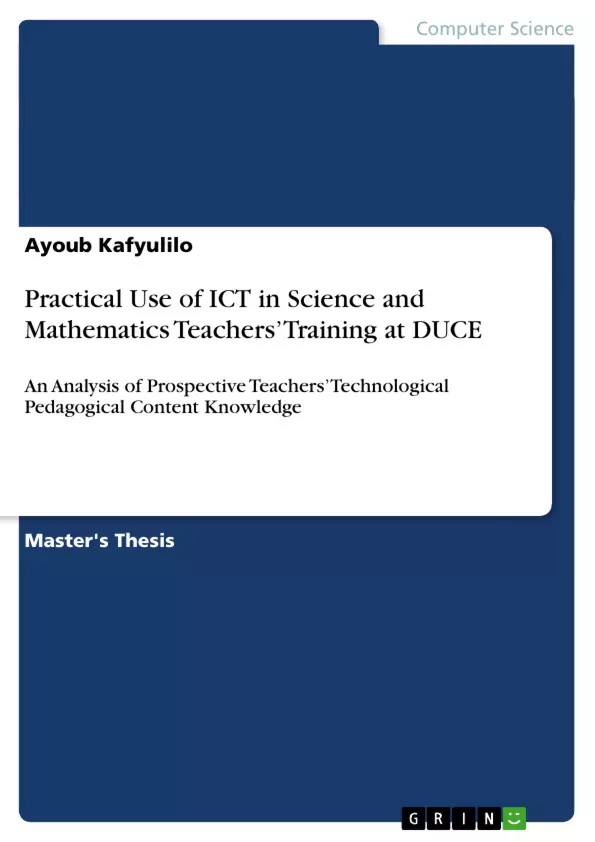This study investigated the ways through which pre-service science and mathematics teachers at Dar es Salaam University College of Education (DUCE) can acquire competencies for integrating technology pedagogy and content in teaching. Specifically the study investigated the preservice teachers’ ICT integration competencies; practices that can be effective in enhancing pre-service science and mathematics teachers’ competency in integrating technology, pedagogy and content; as well as the impact of those practices in the development of preservice teachers’ technological pedagogical content knowledge.
An action research approach was employed in the study, employing the pre and post-intervention assessment of preservice teachers’ knowledge on technology, pedagogy and content. Planed interventions were carried out during the study, to enable preservice teachers to identify areas of weaknesses in their technology integration competencies, and propose alternative approaches for addressing the identified weaknesses. Student questionnaire, instructor interview and observation checklist were used to collect date before, during and after intervention. Researcher’s log book, digital camera and audio recorder were used in recording events and activities taking place during the study.
Findings revealed that when preservice teachers engage in hands on activities such as microteaching, lesson design and the opportunity to share their ideas with peers, they easily developed their technological pedagogical content knowledge. An analysis of knowledge change after the intervention, showed a significant difference between pre-intervention and post intervention preservice
teachers’ knowledge of TPACK. It is therefore concluded that, the adoption of hands on activities that uses technology and involve teachers in planning of what to teach, how to teach and with what technology to teach, and provision of an opportunity to share this plan with colleagues, can make a significant change in the development of TPACK among preservice teachers.
Inhaltsverzeichnis (Table of Contents)
- Acknowledgement
- List of Tables
- List of Acronyms
- Abstract
- Chapter One
- Background of the Study
- Introduction
- Statement of the Problem
- Research Questions
- Contribution of the Study
- Overview of the Study
- Chapter Two
- The Context of Tanzania
- Teaching and Learning in Science and Mathematics
- ICT Policy in Tanzania
- ICT in Schools
- ICT in Teacher Training Colleges
- General Situation
- The Situation at DUCE
- Implementing ICT in Education in Tanzania: What Helps and What Hinders
- Chapter Three
- Theoretical Framework
- ICT Integration in Education
- TPACK in Science and Mathematics Teaching
- TPACK Competencies for Pre-service Science and Mathematics Teachers
- TPACK Training Package for Preservice Teachers
- Summary and Way Forward
- Chapter Four
- Research Methodology
- Research Design
- Participants
- Instruments
- Student Questionnaire
- Instructors' Interview
- Observation checklist
- Researcher's Log Book
- Intervention
- Microteaching
- Training about TPACK
- Peers' Appraisal
- Design of the Lesson
- Presentation of the Lesson
- Reflection
- Data Collection Procedures
- Data Analysis
- Instruments' Validity
- Reliability Analysis
- Chapter Five
- Findings
- Preservice teachers Competency in the Use of ICT in Teaching
- Practices that are Effective in Enhancing Technology Integration Competencies
- Microteaching (one)
- Training (Introducing the Concept of TPACK)
- Design of the Lesson
- Lesson Presentation (Microteaching two)
- Reflection on the Project (post intervention)
- The Impact of the Intervention on TPACK Competency
- Chapter Six
- Summary, Discussion, Conclusions and Recommendation
- Summary of the Findings
- Discussion
- Developing TPACK among Preservice Teachers: Effective Practices
- The Impact of Interventions
- Conclusion
- Recommendations
- References
- Appendix A: Students' questionnaire
- Appendix B: Interview Questions for DUCE Instructors
- Appendix C: TPACK observation checklist (microteaching and classroom activities)
- Appendix D: Worksheet for Simple Pendulum
Zielsetzung und Themenschwerpunkte (Objectives and Key Themes)
This study aims to analyze the technological pedagogical content knowledge (TPACK) of prospective science and mathematics teachers at Dar es Salaam University College of Education (DUCE) in Tanzania. It investigates the impact of an intervention program designed to enhance their TPACK competencies through microteaching, training, and peer feedback. The study also explores the effective practices that contribute to the development of TPACK among preservice teachers.
- The current state of TPACK among prospective science and mathematics teachers at DUCE.
- The effectiveness of an intervention program designed to enhance TPACK competencies.
- The identification of effective practices that contribute to the development of TPACK.
- The impact of the intervention on the participants' TPACK knowledge and integration of technology in teaching.
- Recommendations for improving TPACK development in teacher training programs in Tanzania.
Zusammenfassung der Kapitel (Chapter Summaries)
Chapter One introduces the study's background, problem statement, research questions, contribution, and overview. Chapter Two provides context by discussing the teaching and learning of science and mathematics, ICT policy, and ICT integration in schools and teacher training colleges in Tanzania. Chapter Three presents the theoretical framework, focusing on ICT integration in education and the TPACK model. Chapter Four outlines the research methodology, including the research design, participants, instruments, intervention activities, data collection procedures, and data analysis methods. Chapter Five presents the study findings, including the participants' TPACK competencies, the effectiveness of the intervention program, and the impact of the intervention on their TPACK knowledge and practices.
Schlüsselwörter (Keywords)
This study focuses on the key concepts of Technological Pedagogical Content Knowledge (TPACK), teacher training, ICT integration, and preservice science and mathematics teachers in Tanzania. It explores the effective practices that contribute to developing TPACK competencies and the impact of an intervention program designed to enhance these competencies. The study draws on empirical research findings and contributes to the understanding of TPACK development in educational settings.
- Citar trabajo
- Ayoub Kafyulilo (Autor), 2011, Practical Use of ICT in Science and Mathematics Teachers’ Training at DUCE, Múnich, GRIN Verlag, https://www.grin.com/document/179521



